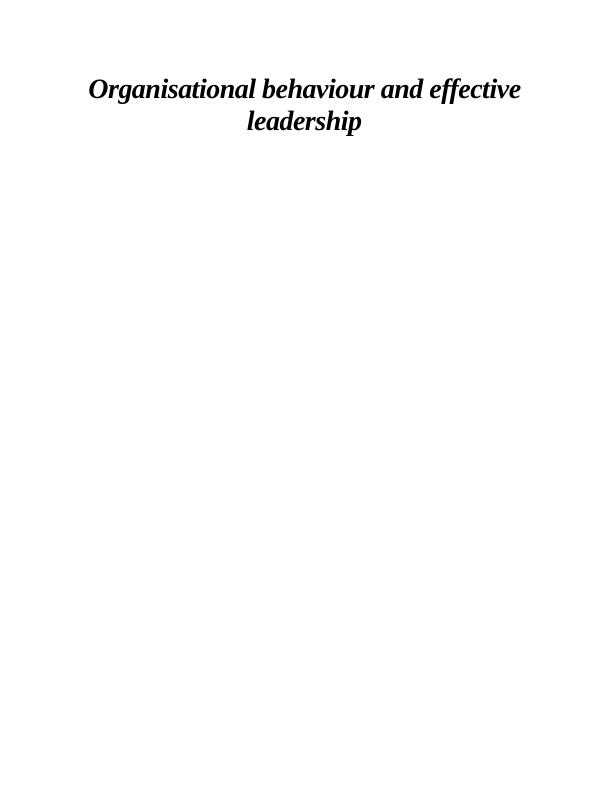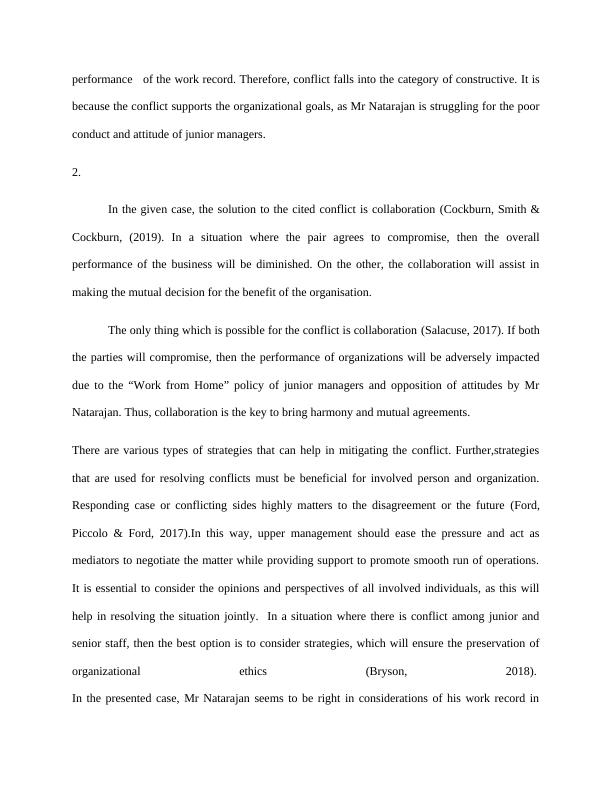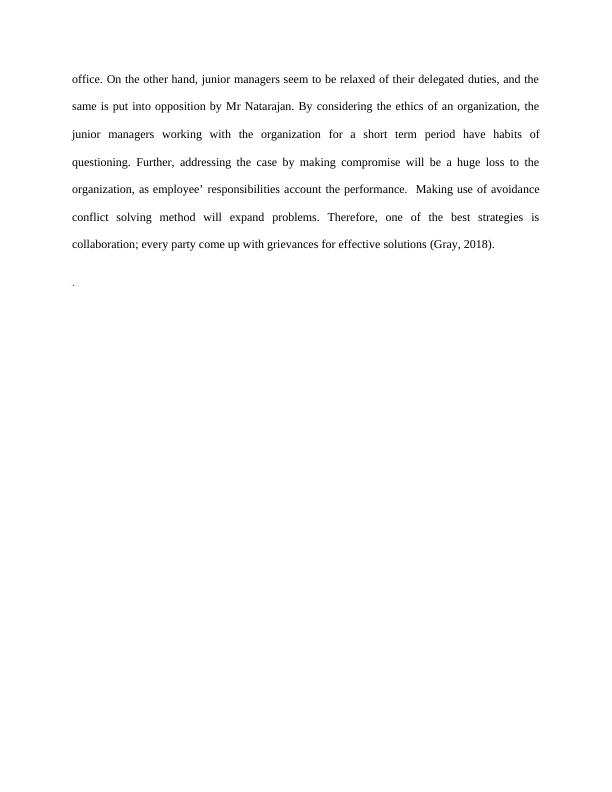Organisational behaviour and effective leadership.
Added on 2023-01-18
12 Pages2564 Words83 Views
Organisational behaviour and effective
leadership
leadership

Case study
1.
By considering the case scenario, it is held that there is a conflict that urges for
immediate action. In the majority of the cases, conflict is beneficial for an organization, only if it
involves functional aspects. The present study will consider various types of conflict which are
presented in the cited organization, plus it will carry out a critical analysis whether the conflict is
either constructive or destructive, thereby providing reliable remedies for the resolution to the
conflicts.
In the given case, Mr Natarajan is working as a senior manager and having experience of
20 years. As per the cited case, he is dissatisfied with the new junior manager. It is because he
does not support his initiatives and is against the “Work from Home” policy. The main source of
conflict was severe strictness and pressure on the discipline of work and reporting time on
subordinates placed by Mr Natarajan. The type of conflict which is evidenced in the present case
is considered as process conflict. Further process conflict is defined as a disagreement on how a
task should be accomplished (Rahim, 2017). It sheds light on the individual responsibility for
organization visuals and for even delegation. However, the conflict is defining more about
responsibilities for the junior manager of the company.
In the given case the conflict is of a functional and constructive nature. Given that Mr
Natarajan has the track record from the last 20 years, the cause of the problem in the conflict was
the new team of staff. Basically, it was not possible for the junior manager to handle the
environment of work required by the top manager who has such a good experience and
1.
By considering the case scenario, it is held that there is a conflict that urges for
immediate action. In the majority of the cases, conflict is beneficial for an organization, only if it
involves functional aspects. The present study will consider various types of conflict which are
presented in the cited organization, plus it will carry out a critical analysis whether the conflict is
either constructive or destructive, thereby providing reliable remedies for the resolution to the
conflicts.
In the given case, Mr Natarajan is working as a senior manager and having experience of
20 years. As per the cited case, he is dissatisfied with the new junior manager. It is because he
does not support his initiatives and is against the “Work from Home” policy. The main source of
conflict was severe strictness and pressure on the discipline of work and reporting time on
subordinates placed by Mr Natarajan. The type of conflict which is evidenced in the present case
is considered as process conflict. Further process conflict is defined as a disagreement on how a
task should be accomplished (Rahim, 2017). It sheds light on the individual responsibility for
organization visuals and for even delegation. However, the conflict is defining more about
responsibilities for the junior manager of the company.
In the given case the conflict is of a functional and constructive nature. Given that Mr
Natarajan has the track record from the last 20 years, the cause of the problem in the conflict was
the new team of staff. Basically, it was not possible for the junior manager to handle the
environment of work required by the top manager who has such a good experience and

performance of the work record. Therefore, conflict falls into the category of constructive. It is
because the conflict supports the organizational goals, as Mr Natarajan is struggling for the poor
conduct and attitude of junior managers.
2.
In the given case, the solution to the cited conflict is collaboration (Cockburn, Smith &
Cockburn, (2019). In a situation where the pair agrees to compromise, then the overall
performance of the business will be diminished. On the other, the collaboration will assist in
making the mutual decision for the benefit of the organisation.
The only thing which is possible for the conflict is collaboration (Salacuse, 2017). If both
the parties will compromise, then the performance of organizations will be adversely impacted
due to the “Work from Home” policy of junior managers and opposition of attitudes by Mr
Natarajan. Thus, collaboration is the key to bring harmony and mutual agreements.
There are various types of strategies that can help in mitigating the conflict. Further,strategies
that are used for resolving conflicts must be beneficial for involved person and organization.
Responding case or conflicting sides highly matters to the disagreement or the future (Ford,
Piccolo & Ford, 2017).In this way, upper management should ease the pressure and act as
mediators to negotiate the matter while providing support to promote smooth run of operations.
It is essential to consider the opinions and perspectives of all involved individuals, as this will
help in resolving the situation jointly. In a situation where there is conflict among junior and
senior staff, then the best option is to consider strategies, which will ensure the preservation of
organizational ethics (Bryson, 2018).
In the presented case, Mr Natarajan seems to be right in considerations of his work record in
because the conflict supports the organizational goals, as Mr Natarajan is struggling for the poor
conduct and attitude of junior managers.
2.
In the given case, the solution to the cited conflict is collaboration (Cockburn, Smith &
Cockburn, (2019). In a situation where the pair agrees to compromise, then the overall
performance of the business will be diminished. On the other, the collaboration will assist in
making the mutual decision for the benefit of the organisation.
The only thing which is possible for the conflict is collaboration (Salacuse, 2017). If both
the parties will compromise, then the performance of organizations will be adversely impacted
due to the “Work from Home” policy of junior managers and opposition of attitudes by Mr
Natarajan. Thus, collaboration is the key to bring harmony and mutual agreements.
There are various types of strategies that can help in mitigating the conflict. Further,strategies
that are used for resolving conflicts must be beneficial for involved person and organization.
Responding case or conflicting sides highly matters to the disagreement or the future (Ford,
Piccolo & Ford, 2017).In this way, upper management should ease the pressure and act as
mediators to negotiate the matter while providing support to promote smooth run of operations.
It is essential to consider the opinions and perspectives of all involved individuals, as this will
help in resolving the situation jointly. In a situation where there is conflict among junior and
senior staff, then the best option is to consider strategies, which will ensure the preservation of
organizational ethics (Bryson, 2018).
In the presented case, Mr Natarajan seems to be right in considerations of his work record in

office. On the other hand, junior managers seem to be relaxed of their delegated duties, and the
same is put into opposition by Mr Natarajan. By considering the ethics of an organization, the
junior managers working with the organization for a short term period have habits of
questioning. Further, addressing the case by making compromise will be a huge loss to the
organization, as employee’ responsibilities account the performance. Making use of avoidance
conflict solving method will expand problems. Therefore, one of the best strategies is
collaboration; every party come up with grievances for effective solutions (Gray, 2018).
.
same is put into opposition by Mr Natarajan. By considering the ethics of an organization, the
junior managers working with the organization for a short term period have habits of
questioning. Further, addressing the case by making compromise will be a huge loss to the
organization, as employee’ responsibilities account the performance. Making use of avoidance
conflict solving method will expand problems. Therefore, one of the best strategies is
collaboration; every party come up with grievances for effective solutions (Gray, 2018).
.

End of preview
Want to access all the pages? Upload your documents or become a member.
